

An Occasional Publication for the Home Boat Builder
Glen-L Marine Designs - 9152 Rosecrans Ave. - Bellflower, CA 90706

In this issue
- Why I must build a boat
- Feedback: Sherwood Queen by Jamie Zaroski
- Lumber cuts
- Feedback: Glen-L 25 by Jim Ditty
- Tuffy Tug, early dreams, early childhood by Dr. James Sanders
- Feedback: Geronimo by Jim Pesci
- Feedback: Sweet Caroline
- Feedback: Dyno Jet by Gordon Scrim
- Marine Plywood, True or False
- Feedback: Tiny Might by Bob Hankins
- Recent email
GLEN-L Update
- The "Outdoor Channel" on cable TV is starting a new program: "Boating Today". A crew stopped by this last month to interview us, then two local builders of Glen-L designs. I don't know when this will air, but some of you might find the program of interest. Will post more in an upcoming WebLetter if we find out an air date.
- We have been working on the Online Store. It seems we get waaay beyond the normal amount of traffic, resulting in a very large "extra bandwidth" charge. Our provider said that virtually no one goes over the minimum and were almost as surprised as we were about the amount of the additional charge. We have reorganized the site so that most of the browsing is now done outside the "store". Most visitors should not notice any difference. We have also been finishing the Inboard Hardware section in order to get it into the store. This is taking longer than we expected since we are now trying to make sure that most browsing is done on our site, with minimal browsing done within the store. Will have more to report in the next WebLetter.
- We have received some inquiries regarding the Glass-bottom boat presently under development. We've had a spate of Frame Kit orders for kits not in stock, so the Glass-bottom boat languishes. We have posted a few photos, but little else is yet available. Photos
Editor
Why I must build a Boat
The English writer Arthur Ransome, author of the wonderful Swallows and Amazons series of books for children, had a boat built in Latvia in the early 1920's. In "Racundra's First Cruise", his account of her, he wrote as follows:
"Houses are but badly built boats so firmly aground that you cannot think of moving them. They are definitely inferior things, belonging to the vegetable not the animal world, rooted and stationary, incapable of gay transition. I admit, doubtfully, as exceptions, snail-shells and caravans. The desire to build a house is the tired wish of a man content thenceforward with but a single anchorage. The desire to build a boat is the desire of youth, unwilling yet to accept the idea of a final resting-place. It is for that reason, perhaps, that, when it comes, the desire to build a boat is one of those that cannot be resisted. It begins as a little cloud on a serene horizon. It ends by covering the whole sky, so that you can think of nothing else. You must build to regain your freedom. And always you comfort yourself with the thought that yours will be the perfect boat, the boat that you may search the harbours of the world for and not find."
His words are as true today as they were in 1923, which is why this 60-year-old youth will shortly start building his retirement dream-ship.
Mike Burch
Feedback: Sherwood Queen
by Jamie Zaroski
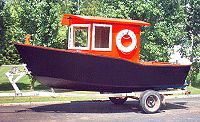
I started building the Sherwood Queen right after Christmas and launched it on June 15th. I live in Thunder Bay Ontario Canada on the Kaministiqua River, which flows into Lake Superior. I followed the plans for the hull but modified the cabin. I am using a 1968 Johnson 10 hp. Top speed is 7 1/2 miles per hour and uses 1 gallon of gas per hour at 3/4 throttle. I plan to use it for cruising and fishing on Lake Superior for lake trout and salmon. The boat handles 3 foot waves with ease. I have installed navigation lights, horn, bilge pump, fish finder, compass and vhf radio. The final cost was 4,000 cdn., not including trailer and motor.
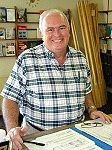
Visitor
We had the pleasure this last month of a visit from Wayne Armstrong, Queensland, Australia. Wayne is building the Quest.
Lumber cutsI recently added a lumber supplier to our List of Lumber Suppliers. While reviewing the site I came across the term "Flitch sawn"; I had no idea what this meant. I found the definition and a few other terms that I thought might be of interest to boatbuilders at http://countryworkshops.org/.
|
Feedback: Glen-L 25
by Jim Ditty
About 30 years ago, I built a Glen L 17 Sailboat. It was a fine boat, but I wanted one with more room, so about 1975 purchased a Glen L 25, previously built by another sailor. A photo of this boat, "Kestrel" once appeared in your catalogue.
I did some modifications that may interest other
Glen L owners.
These include......
1) Higher seat-backs in the aft portion of the cockpit, to enhance
comfort.
2) A double hatch arrangement in the cabin top that allows the aft hatch to
slide over a forward one, and both hatches to be set over on the starboard
cabin top. This results in full open standing headroom forward to nearly the
placement of the mast. We almost always sail with this space open.
3) Under the aft section of the counter top is a two chamber icebox that
features separate ice and dry compartments, each with a valve-controlled
drain.
4) Just aft of the hanging closet is a chest of drawers topped by an
"Igloo" drinking water jug.
5) Over the settee table is a drop down food locker.
6) Several storage compartments hold various galley equipment.
7) The counter top and settee table are surfaced in decorative plywood and
edged with fiddles to retain items when heeling.
8) The counter top conveniently holds an alcohol stove which fits neatly under
the counter when not in use.
9) The mast support is a decorative wooden post, finished bright!
10) As we now keep Kestrel in a marina slip all summer, we have added the great
convenience of a 130% roller furling jib.
Over the years, we have enjoyed sailing Kestrel in a number of lakes of Northern California and Oregon, as well as San Diego Bay and the San Juan and Canadian Islands in the Pacific Northwest.
For a number of years now we have sailed Lake Tahoe all summer, keeping Kestrel in the aforementioned slip at Meeks Bay Marina. Now in our seventies, my wife and I still enjoy Kestrel immensely.
Attached are five photos, showing most of the above mentioned modifications. I would be glad to furnish further details to you or other sailors!
Tuffy Tug
|
Feedback: Geronimo
by Jim Pesci
Saturday evening I went out for the first time at Gravelly Point on the Potomac river. I launched right across from the capitol and monuments in Washington DC. It was a great weekend. I had no real problems launching, it was a little hard getting the motor started but it only took a minute. Some of those guys are very fast at launching, like in 2 minutes total. I took note to improve my skills.
The depth finder works great. I headed for the channel and went down stream toward Alexandria where they were having the harbor fest. 10,000 maniacs were playing. I was cruising along about 25 and the wakes from other boats made it very bouncy with the bow bobbing up and down with some minor slamming on the water. At one point it was a little scary as I didn’t cut the angle sharp enough over a large wake and the hull rolled to starboard quite a bit. Anyway, I now know the exact location of the no wake zone as I got nailed for speeding in it by the cops and got a warning. No fine, just minor humiliation as the anchored big boats watched.
I was going to try to anchor but kept getting blown around and my neighbor who came along for the ride was not helpful. We decided to turn back and head for the launch ramp. Everything was going fine and thank God for GPS cuz it was getting dark and was hard to see. Before getting back to the ramp the motor began sputtering and then stalled while in the channel. The wind blew me around a bit and in a minute I got the fuel hose reconnected and restarted the motor. Only a minor spill of gas in the river, which might help kill the toxic fecal matter which pollutes it. We got back to the ramp and loaded and took her home. Total success for the first time.
I noticed my RPM was reading very high like 5 and 6 thousand while at speed (25mph). I made the adjustment to the pitch after I got home but haven’t tried it yet. When we left the ramp initially, it seems like it could get on plane around 3500. I still haven’t mastered the trim control and just left it in the down position. The speed seemed slow for the rpm and I noticed that it was taking a little time to get a bite and the speed would rise gradually. On the way back to the ramp I was unable to get on plane as I had taken on some water in the bilge. My transom drain plugs are leaky, I'll be replacing them this week for a tighter seal. I still have things to do and will be deciding on some different seating. The first time out was great fun and I really enjoyed it.
 Well, I used to fish... but it got in the way of my boat building. |
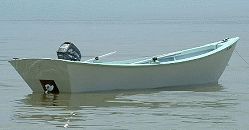
Feedback: Sweet Caroline
by Name removed by request
This boat handles beautifully. Last weekend was the first beach camping trip along Lake Michigan and I'm very satisfied with the capabilities and performance of this boat. There's ample room to stow camping gear. The bench seats covert nicely to a double berth. The boat floats in 3"-6" of water and the fuel consumption should give a respectable range (~1.2 gal./hr.). My only complaint is with the motor well. I built the motor well around a 15" shaft, but found that the new four strokes had a hard time swinging from stop to stop within the well. I added a 20" motor board to fit a Nissan 18 hp motor which drives the boat at 12 mph at half throttle and 15 mph at full throttle. The 25 hp 4 strokes just would not fit. I wish the motor would move the boat at 20+, but 12-15 is very comfortable. Slosh boards have taken care of most of the water that splashes in through the motor well. A pair of small bilge pumps take care of the rest. The next step is to add camping canvas and possibly floatation. I met another boater over the weekend with a similar homebuilt design that had a hinged door covering the outflow in the transom. He claimed to have run the boat in 10' seas and said that the small door swings shut with following seas. Thoughts anyone?
Feedback: Dyno Jet
by Gordon Scrim
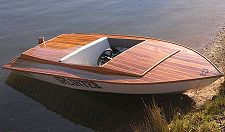
Our Dyno-Jet is now finished and has been officially launched!
The motor and pump is from a 1988 650SX Kawasaki Jet-Ski - one of the stand up types. It is a 650cc engine and should produce about 50 HP. The boat reaches a speed of 35mph with one person on board and is a real hoot to drive fast up smaller twisting rivers. We have also towed two big kids on knee boards with it. The boat is all marine ply with Tassie Oak (basically Gum trees) being used for the frames. The deck is made of 4mm thick planks of Tasmanian Blackwood with 6mm X 4mm Celery Top Pine strips in between.
I have updated my web site of the boat showing some photos from on the water and on the land. I have also moved the web site to a new and larger home.
It is now at www.ozsoft.com.au/splinter/default.htm.
Also attached are some of the best photos of the finished boat that we have. I have lots of photos of the building process if anyone is interested. The best of them are one the web site.
Tasmania Australia
Marine Plywood: True or False?
I was recently directed to a website selling Marine plywood. After reading the introduction, I wondered why they felt in necessary to exaggerate the qualities of what is, in fact, a superior product. The following are some of the statements made; the True/Flase replies are mine.
The thing is, Marine plywood is always a better choice for hull construction, but it is important to understand why this is the case. It really is counter productive to make up reasons to use it. When people realize claims are false, they tend to doubt the legitimate reasons for using a product as well.
Feedback: Tiny Might
by Bob Hankins
Well, I finally finished my Tiny Might, as you can see by the pics.
I used a Honda V-Tech, 125 hp. I had a hard time getting the computer in and working properly, and then getting the engine to run at the proper temperature. I finally went to a heat exchanger, closed cooling system and it works great. Although the Honda V-Tech was not an easy engine to install, it works very well. With a 10x15 2-blade steel prop, the top speed (that I was willing to push it to at the time) was 50 mph and still climbing. What a kick!
While I spent 4 years on the boat (mostly in the spring and fall, because of the temp. in my garage), it was worth it. However, if I had to do it again, I would build the 15 footer (Cracker Box), because of parts availability and it could be used to ski with... but, I'm very happy with what I now have.
It sure draws a lot of attention at the ramp. Even the park ranger took some pictures of it.
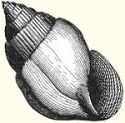
Recent email:
Subject: Malahini
Date: Wed, 20 Jul 2005
Completed the Malahini late spring, just under 2 years. Mahogany frames, marine plywood, mahogany decking and Interlux Brightsides paint on hull. Total lumber cost about $1900, assorted parts and hardware $2900. The windshield brackets were the greatest disappointment, very hard to find and poor quality, may replace then at some time in the future. Installed a "used" 50 Hp Suzuki 4-stroke, the largest expense. The boat handles great.
Attached photos, still need photos on the water. Thanks for a great set of plans.
Scott Means
The story of this boat appeared in WebLetter 65.
Subject: Sea Knight
Date: Mon, 4 Jul 2005
Hi Barry,
The transom has now been modified... Also, we now have a cockpit. I just thought I'd send you some pictures.
Best regards,
Tamas Kirchknopf
Subject: Wasted Seaman
Date: Tue, 12 Jul 2005
Hello again from Bermuda,
Well, the Wasted Seaman is now in her 12th year and is still going strong.
She does need
another spray job and a little TLC on the bright work but structurally she is
solid. You may ask yourself... what do you do with an 18 foot Cabin Skiff for
12 years? Well, you can cruise the shoreline with your dog....
does need
another spray job and a little TLC on the bright work but structurally she is
solid. You may ask yourself... what do you do with an 18 foot Cabin Skiff for
12 years? Well, you can cruise the shoreline with your dog....
Scott Amos
Smith's Island, Bermuda
Below is the result of your feedback form. It was submitted on Sunday, July 3, 2005
---------------------------------------------------------------
name: William R. Bloodgood
Comments: I finished building your Monsoon and promptly sold it. I think my next project is going to be the Glen-L 25 sail boat. I'll keep that one for myself.
Below is the result of your feedback form. It was submitted on Tuesday, June
28, 2005
----------------------------------------------------------------
name: Tim Flack
Comments: I have gone through every customer photograph that you have on your web site. Now I am working like heck to finish all my home projects so I can make room for a boat building project. I enjoy seeing others having fun with the building and using process.
Subject: hello do you want know my boat
Date: Mon, 20 Jun 2005
Hello I'm Joe from China excuse my english is basic. I have built a pedal boat in this year. I want to try through east china sea but did not to do. I hope find same lover build a new boat to try again. Picture of my boat ...
This has absolutely nothing to do with Glen-L, but I thought it was interesting. I think his message lost something in the translation, but the photos tell the story.
Below is the result of your feedback form. It was submitted on Saturday,
June 18, 2005
--------------------------------------------------------------------
name: Graham Hinton
Comments: I enjoy spending time on your website. Aside from the wide range
of boats to choose from, there is so much back up information on the actual
construction as well as the ancillaries required to complete the project.
Great site.
From: "Andy Anderson"
Date: Sun, 19 Jun 2005
Hi Gayle,et al: Long time. Attached is pix of latest boat. This is a 9”
model and a far cry from my old favorites by Glen-L. Kinda too bad the old man
and his boats is relegated to this level but it beats no level at all.
Best regards. Andy
Build more boats
GLEN-L boats, of course

